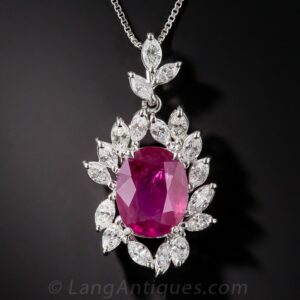
Ruby is the red variety of sapphire or the mineral corundum. When corundum occurs in any color, other than red, it is referred to as a sapphire. Rubies are primarily mined in Burma, Madagascar, India and Eastern Africa. The most renowned source of fine-quality rubies is Burma, known now as Myanmar.
The value of a ruby is determined by the intensity of its red color. The most valuable rubies will be a medium tone, intense RED without any modifying tones of violet, orange, gray or brown and are transparent in clarity. Rubies that are too light or too dark will be less highly valued.
With the exception of some rare colored diamonds and imperial jadeite, fine rubies still command the highest prices paid for gemstones.
A Brief History of Ruby
The ruby mines of the Mogok district of Burma (now Myanmar) are older than history: Stone Age and Bronze Age mining tools have been found in the mining area there. In ancient Burma, it was believed that rubies would ripen in time, just like fruit ripens on a tree. They also believed that implanting a ruby into their flesh would make them invulnerable in battle.
The ancient Greeks cherished rubies as living pieces of coal that stored vast amounts of heat and when placed in water, may cause the water to boil.
The Roman author Pliny, in the First Century AD, described rubies as having gender. He also instructed that one could easily tell the difference between a genuine ruby and a glass imitation by the weight of the gem. The genuine ruby will be much heavier. Rubies were made into pendants to guard against poison, plague, evil thoughts, and wicked spirits.
Ruby is the birthstone of July and the gemstone for Cancer. Ruby commemorates the 15th and 40th anniversary and is the sacred gem of Friday.
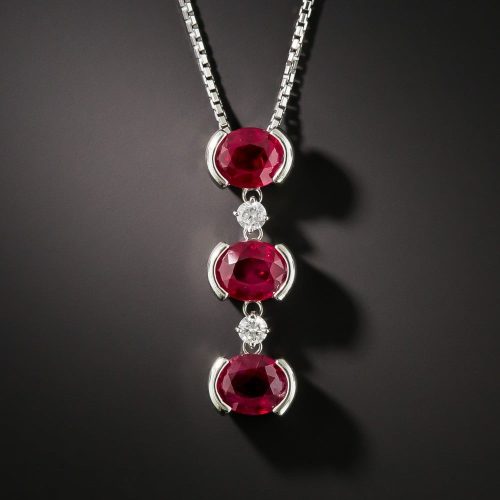
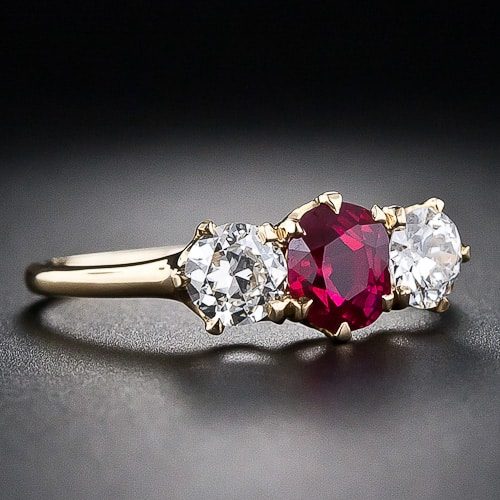
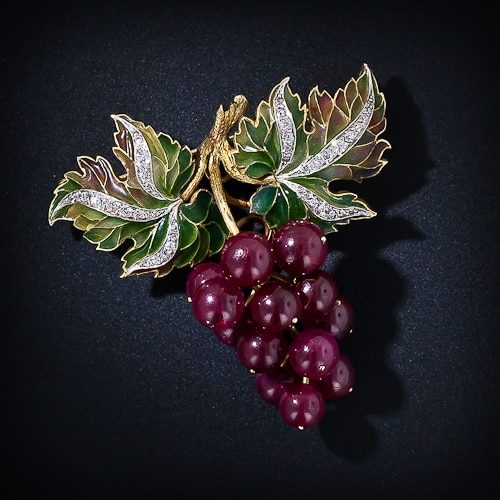
Etymology
Ruby comes from the Latin word for red: ‘ruber’. The medieval Latin adjective ‘rubinus’ was derived from ‘ruber’ and eventually started to be used as a noun for red corundum. From there it was a small step from rubinus to ruby.
History
Ancient History
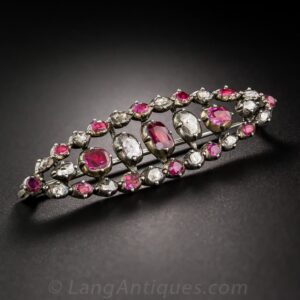
The area around Mogok, Myanmar has seen human habitation since the middle paleolithic period. It is not so hard to believe that these early inhabitants would have stumbled upon the fine rubies of this locality and kept them as decoration, amulets, or maybe even tools.
Archaeological investigations have been very scarce. The restrictions for foreigners to enter the country that were been put into place by the military regime of Myanmar prevent us from getting a clear picture of the ancient inhabitants of the area and their use of rubies. Another ancient source of gem corundum has been Sri Lanka.
We can find written accounts of red stones that could be ruby in the writings of Theophrastus who speaks of red stones that resemble hot coal when viewed with the sun behind it. He calls this stone anthrax but whether he was describing garnet, spinel or ruby isn’t clear. Pliny‘s account on red stones is similarly vague and seems to describe more than one red gemstone under the same name; carbunculus. An interesting note is that Pliny mentions glass imitation stones that can be distinguished from genuine gemstones by hardness and inclusion studies.
After the fall of the Western Roman Empire, the epicenter of science moved east a bit. Arabic scholars during the second half of the first millennium AD speak of Yakut, a term used for corundum and a few other gemstones. It is believed that red Yakut is correctly translated to ruby. The writers of Asia Minor had a far better knowledge of ruby localities than the classical writers and when one reads the descriptions known deposits like Badakshan and Sri Lanka can be recognized. One polymath in particular leaves very little doubt that he is describing ruby; the 11th-century scholar Al-Biruni, who conducted specific gravity determinations on a whole series of gemstones. His findings are very accurate; he lists a specific gravity of 3.85 for ruby. Two centuries later the Europeans were still fumbling around in the dark. This can be seen in the writings of Albertus Magnus who erroneously mentions Libya as a major locality, a mistake most likely to have come from reading the 11th-century lapidary from Marbodus. Rubies from present-day Afghanistan, Sri Lanka, and Myanmar would have reached Europe through the ports on the eastern shore of the Mediterranean up until then.
When Western European armies went on their crusades in the 11th and 12th centuries they encountered (and looted) the riches of the Arabic world. With it came a revived interest in the East and its economic potential. The travel logs of Marco Polo, written in the 13th century were the first eyewitness accounts of the world to the east of present-day India and his memoirs have inspired many to travel to the East and harvest its riches. The centuries after Polo’s journey are the ages of discovery that brought new gemstones to the West along with a better understanding of their nature and origin.
Renaissance & Enlightenment
The increased contact with the advanced Arabic scholars from the 11th century and later the invention of movable print during the last years of the Middle Ages engendered a new level of knowledge among European readers. Accounts from de Boodt and Nicols – the authors of two lapidaries of the 17th century – discuss rubies, their deposits and their use in greater detail than any of their European predecessors. The 18th century is marked by a further growing mineralogical consciousness until finally ruby and sapphire were both recognized as corundum around 1800.
Modern History
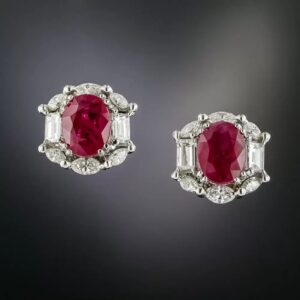
The heat treatment of ruby to improve color and clarity is described in some of the earliest known sources on the subject. The beginning of the 19th century saw the invention of the gas blowpipe which enabled higher temperatures to be reached than had ever been achieved previously. E.D. Clarke published details of his experiments with it:
..two rubies were placed upon charcoal and exposed to the flame of the gas blowpipe… after suffering it to become cold… the two rubies were melted into one bead.1
Across the 19th century, attempts had also been made to create man-made rubies. A few less fruitful attempts made in the 1830s inspired the head of the chemistry laboratory of the Natural History Museum in Paris, Edmond Fremy, to take up the cause. He managed to produce small rubies by heating the raw materials for ruby in a flux that causes them to dissolve at much lower temperatures. Cooling of the flux, containing the dissolved ingredients, caused crystallisation of rubies. One of Fremy’s assistants, Auguste Verneuil finally managed to create large enough crystals of synthetic ruby with a revolutionary method that still bears his name.
But, not all was artificial. The 19th century brought European miners to the Mogok Valley in Myanmar and large amounts of ruby were mined and introduced to the Western markets.
Contemporary History
The 20th century has seen a score of inventions that allowed advanced heat treatment techniques, new methods of synthesis and filling techniques to emerge.
Shop at Lang
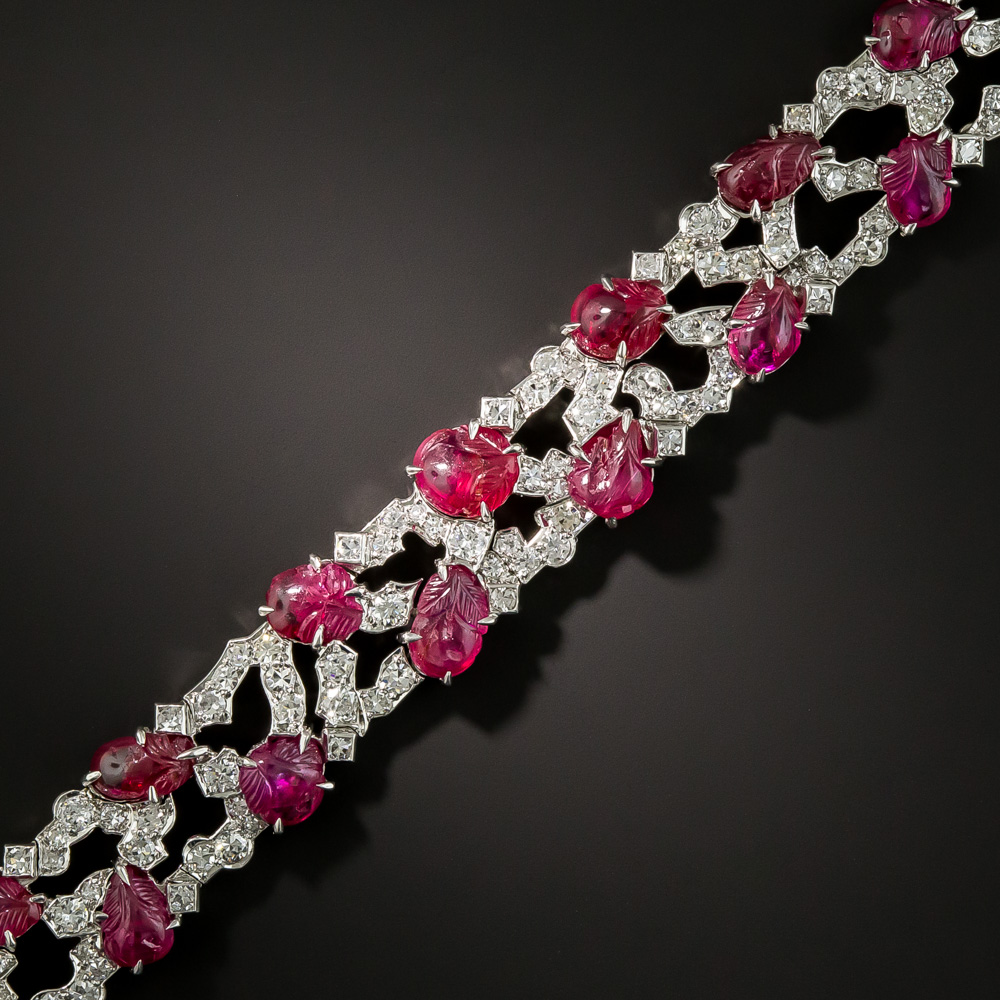
Art Deco Carved Ruby and Diamond Bracelet by Trabert & Hoeffer, Mauboussin
In this chic, sophisticated, and stunning Jazz Age jewel, twenty bright translucent red rubies - hand-carved in a decorative fruit motif - gleam from within a f…
SHOP AT LANG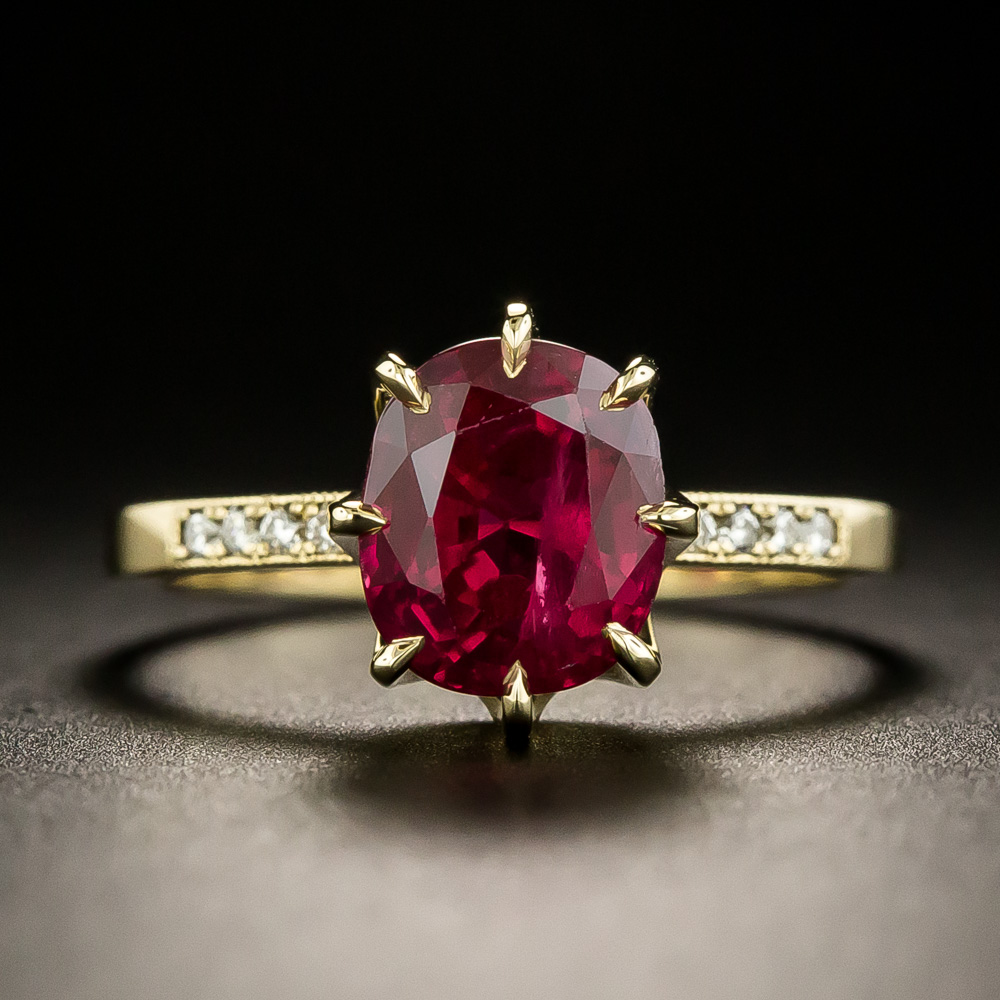
Lang Collection 3.01 Carat Gem Ruby and Diamond Solitaire Ring
Red! You want red? We got red! This magnificent and exotic gemstone, a 3.01-carat cushion-cut ruby, by way of Mozambique, casts a truly gorgeous, richly saturat…
SHOP AT LANG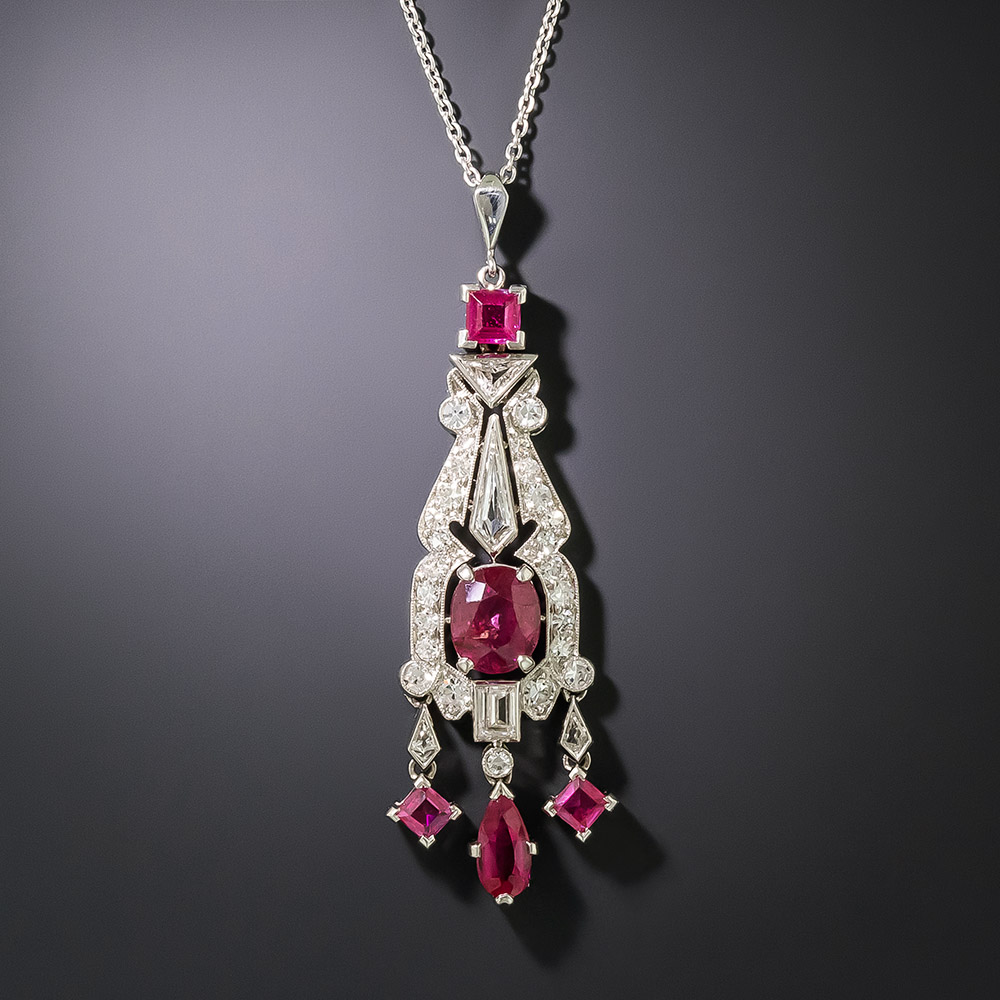
Art Deco 1.90 Carat No-Heat Burma Ruby and Diamond Pendant
Electric color, lots of sparkle and a captivating cornucopia of stone shapes coalesce to create this sleek and sexy Art Deco pendant necklace from Austria(!), c…
SHOP AT LANG
Major Localities for Ruby
| 2Time | Locality | Comments |
|---|---|---|
| pre 543 BC | Sri Lanka | With hominid habitation going back as far as half a million years ago and proof of stone cultures emerging some 12,000 years ago, it is likely that Sri Lankan’s ruby mining history goes back quite a long way. The first Sri Lankan sapphires and rubies to appear in Western jewelry are those set in Etruscan jewelry. Sri Lanka has seen a continuous mining of it’s corundum deposits since. Thousands of localities lie scattered over the island and numerous historical references leave no doubt that this island has been the source of rubies for over 2000 years. |
| pre 600 BC | Myanmar | When discussing ruby one has to state Mogok as being the ultimate locality for this mineral. Possibly a source for ruby since paleolithic and neolithic times the locality is mentioned in ancient legends. The first Europeans to visit the area and report on the stunning gems lived in the 15th century. The Mogok mines have been subject to short-lived European exploitation in the 20th century but are now closed for foreigners. The quality of fine Mogok ruby is equaled by none. A second deposit was found in 1991 at Möng Hsu although these rubies are often riddled with fractures and are commonly filled. |
| pre 951 AD | Afghanistan | Two main localities of which one has been known since at least since the 10th century. Written accounts that discuss ruby mines in Badakshan (on the border with Tajikistan) teach us that these mines were known and being worked since at least that time. The second deposit is situated close to the present capital Kabul at Jagdalek, a locality that seems to have been discovered much later. The earliest mention of them that was found by RWH is from 1881. |
| pre 1408 AD | Thailand/Cambodia | Rubies high in iron content have been found in large numbers near Chantaburi, in the south-east of the country on the border between Thailand and Cambodia. Their color is often described as dark, or brownish, but the vast quantities of facet grade material caused the mines to be worked heavily during the second half of the 20th century. |
| post 1891 | Madagascar | Various localities have produced ruby along with sapphires of all colors. The gems of this geological paradise were first described in 1547 but it has taken the world another 400 years to see the significance of these deposits. |
| 1950 | Tanzania | From the 1950s on, Tanzania’s gem mining has gradually taken on serious proportions. With ruby deposits from the north to the south and all along a 200-300 km wide belt in the east of the country, Tanzania is a very important ruby locality and new deposits are still being discovered to this day. The Gemresearch video presentation below provides an insight into the mining activities of the Winza ruby deposit: |
| 1973 | Kenya | Various deposits are scattered over the country but the most important deposit lies at Mangari in the south-east of Kenya. Ruby was first discovered at this locality by John Saul and Elliot Miller, two American geologists who claimed a mining lease over the deposit in 1973. They never got to mine it though as the two were quickly chased out of the country when it became clear how significant their find was. |
| 1970s | Vietnam | The first major discovery of ruby in Vietnam was made in the north of the country in the province called Luc Yen. The potential of the ruby deposits weren’t recognized until the end of the 1980’s when commercial mining began and the world learned of Vietnam’s beautiful rubies. |
| 2008 | Mozambique | A new ruby deposit has been found at the border of Zambia in Mozambique. |
Gemological Information for Ruby
| Color: | Red |
| Crystal Structure: | Trigonal |
| Refractive Index: | 1.762-1.770 |
| Durability: | Very Durable |
| Hardness: | 9 |
| Family: | Corundum |
| Similar Stones: | Confusion is Possible with Garnet, Spinel, Red Tourmaline and Red Beryl |
| Treatments: | Sometimes Heat Treated and/or Fracture Filled, Bulk Diffusion |
| Country of Origin: | Myanmar, Madagascar, Australia and Many Other Sources |
Ruby Care
| Ultrasonic Cleaning: | Usually Safe |
| Steam Cleaning: | Usually Safe |
| Warm Soapy Water: | Safe |
| Chemical Attack: | Avoid |
| Light Sensitivity: | Stable |
| Heat Sensitivity: | May Fracture |
Gems & Gemology: The Quarterly Journal of The Gemological Institute of America.
Ruby:
- March-April 1935, Dichroic Colors in Ruby, p. 222, 1p.
- Spring 1936, The Ruby Mines of Burma, p. 3, 4pp.
- Summer 1936, p. 31, 4pp.
- Spring 1940, Differences Between Burmese and Siamese Rubies, by Gübelin, p. 69, 4pp.
- Winter 1940, Characteristics of Rubies from Ceylon, by Gübelin, p. 121, 4pp.
- Fall 1956, The Ruby Mines of Mogok, Burma, p. 335, 8pp.
- Summer 1962, Rubies from Kenya (new deposit), p. 316, 2pp.
- Winter 1962, Repeated Twinning Lines in Both Synthetic and Natural Rubies, p. 378, 2pp.
- Winter 1962, Wax-Treated Rubies, p. 382, 1p.
- Summer 1963, A Star Ruby with a Bull’s-Eye Effect, p. 40, 2pp.
- Winter 1965, The Rosser Reeves Ruby, 138.7 cts., Largest Gem Star Ruby Recorded, p. 367, 1p.
- Spring 1967, Very Unusual Absorption Spectrum Seen in Tanzanian ruby, p. 138, 2pp.
- Summer 1968, A Natural Ruby with Unusual Character, p. 311, 2pp.
- Spring 1969, Notable Rubies in the Crown Jewels of Iran, by Meen, p. 10, 2pp.
- Spring 1971, A 1795 ct. Mysore-Type Cabochon Ruby, p. 278, 2pp.
- Summer 1971, The Lovely Roiled Structure of Fine Burmese Rubies, p. 318, 2pp.
- Summer 1972, A Ruby with Epoxy Filling in Chipped Area, p. 38, 2pp.
- Winter 1973, Unusual 12-Rayed Star Ruby with Two Meeting Points, p. 254, 1p.
- Summer 1974, A Very Rare Liquid and Gas Inclusion in a Natural Ruby, p. 313, 2pp.
- Fall 1974, A First Look at Rubies from Kenya, p. 334, 3pp.
- Spring 1975, A Rock Showing a Mixture of Ruby and Green Tourmaline, p. 27, 1p.
- Spring 1975, A Carved Rock of Chrome Green Zoisite and Ruby, p. 28, 1p.
- Summer 1976, Unusual Liquid and Gas Inclusions in Ruby, p. 170, 2pp.
- Fall 1979, Australia Adds Rubies To Its Mineral Riches, by Rex Scarbary, p. 220, 3pp.
Online G&G Articles on Synthetic Ruby
- Spring 1937, Unusual Inclusions in Synthetic Ruby, p. 91, 2pp.
- Summer 1949, Reconstructed Rubies in Rod and Faceted Form, by Alexander, p. 184, 2pp.
- Summer 1949, Reconstructed Rubies, by Gübelin, p. 186, 3pp.
- Summer 1949, Reconstructed Rubies, by Anderson, p. 187, 2pp.
- Spring 1951, Reconstructed Rubies Seen in New York Lab, p. 29, 1p.
- Spring 1952, Many Reconstructed Rubies Found to be Synthetic Corundum, by L. Benson, p. 139, 7pp.
- Winter 1952, Second Largest Synthetic Star Linde Ruby, 82.93 cts. (Largest Know, 109.25 cts.), p. 259, 1p.
- Winter 1960, Ruby With Synthetic Overgrowth, Gübelin, p. 105, 9pp.
- Summer 1961, Crackled Synthetic Ruby, p. 181, 1p.
- Winter 1962, Repeated Twinning Lines in Both Synthetic and Natural Ruby, p. 378, 2pp.
- Fall 1964, Crackled Synthetic Ruby, p. 215, 2pp.
- Winter 1964, Parting Lines in Synthetic Ruby, p. 251, 1p.
- Spring 1965, Flux-Fusion Synthetic Ruby, p. 270, 3pp.
- Fall 1965, Synthetic Star Ruby from Between 1947-1952, p. 331, 2pp.
- Winter 1965, Solution-Grown Synthetic Rubies, p. 361, 2pp.
- Spring 1966, Solution-Grown Synthetic Rubies, p. 20, 2pp.
- Spring 1966, Flux-Fusion Synthetic Rubies, p. 24, 2pp.
- Fall 1966, Solution-Grown Synthetic Rubies, p. 68, 4pp.
- Winter 1966, Chatham Synthetic Rubies, p. 110, 3pp.
- Winter 1966, Flux-Grown Synthetic Rubies, p. 121, 2pp.
- Spring 1967, Flux-Grown Synthetic Rubies, p. 141, 3pp.
- Summer 1967, Flux-Fusion Rubies, p. 188, 2pp.
- Fall 1967, Flux-Fusion Rubies, p. 205, 2pp.
- Spring 1969, Kashan Flux Grown Rubies, p. 30, 5pp.
- Winter 1969, Flux-Grown Synthetic Rubies, p. 112, 6pp.
- Fall 1970, Hexagonal Platelets in Chatham Flux-Melt Rubies, p. 234, 2pp.
- Spring 1971, Synthetic Rubies Treated to Look Natural, p. 275, 2pp.
- Summer 1971, A New Kashan Ruby (a Crystal Aggregate), p. 316, 2pp.
- Summer 1971, An Unusual Flux-Fusion Synthetic Ruby, p. 320, 2pp.
- Winter 1971, Crackled Synthetic Ruby; Bubbles in Synthetic Ruby, p. 377, 1p.
- Summer 1972, A New Flux Synthetic Ruby (Uses Verneuil Ruby Seed), p. 55, 1p.
- Winter 1972, A Perfectly Good Fingerprint Inclusion in a Verneuil Synthetic Ruby, p. 115, 1p.
- Spring 1973, Interesting Verneuil Synthetic Ruby Inclusion, p. 146, 2pp.
- Summer 1973, Crackled Synthetic Ruby, p. 186, 2pp.
- Spring 1975, Quench-Crackled Synthetic Rubies, p. 16, 3pp.
- Spring 1975, Flux-Grown Synthetic Rubies (Beware), p. 17, 2pp.
- Fall 1975, Flux-Grown and Flame-Fusion Synthetic Rubies, p. 89, 2pp.
- Winter 1976, Flux-Grown Synthetic Rubies, p. 126, 2pp.
- Summer 1976, A Flux Synthetic Ruby on a Flame-Fusion Synthetic Seed, p. 174, 2pp.
- Fall 1979, Synthetic Rubies, p. 206, 3pp.